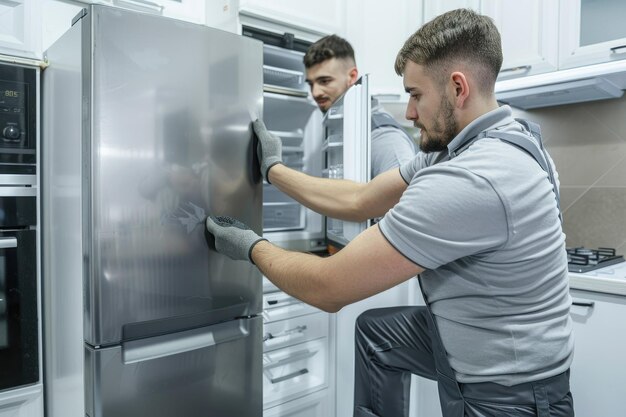How Quickly Can Your Fridge Chill? Unveiling the Cooling Mysteries
When you first plug in a new refrigerator or after a power outage, one pressing question might cross your mind—how long does it take for a refrigerator to cool down? Understanding the cooling process can be essential for proper food storage and ensuring the longevity of your appliance. This comprehensive guide explores the ins and outs of refrigerator cooling times, practical tips to enhance efficiency, and related insights into maintaining your fridge for optimal food storage and shelf life.
🧊 The Cooling Timeline: What to Expect
When a refrigerator is first turned on, it doesn't start cooling instantly. Various factors come into play that influences how long it might take:
Typical Timeframe
Most new refrigerators take between 24 to 48 hours to reach optimal cooling temperatures. However, this can vary based on the following factors:
- Refrigerator Model and Size: Larger units may take longer compared to compact versions. More advanced models with better technology might cool faster.
- Initial Temperature: The ambient room temperature can significantly affect the time needed. A refrigerator started in a warm room might take longer to cool.
- Content Load: An empty refrigerator might cool faster, but food inside can help stabilize temperatures once cooled.
Temperature Goals
Refrigerators are generally expected to maintain a temperature below 40°F (4°C) for the safe storage of food. The freezer compartment should be at 0°F (-18°C). It's vital to monitor these levels, especially when starting a new refrigerator.
🤔 Factors Affecting Cooling Time
Several variables can influence how quickly a refrigerator cools down:
Location and Ambient Conditions
Where you place your refrigerator matters:
- Avoid Direct Sunlight: Exposure to sunlight can warm the fridge exterior, slowing down cooling.
- Ventilation Space: Ensure adequate space around the refrigerator for air circulation.
- Ambient Temperature: A cooler room aids in faster refrigeration processes.
Usage Habits
How you use your refrigerator impacts its efficiency:
- Frequent Opening: Limit opening the doors, particularly during the initial cool-down period. Each opening lets warm air inside.
- Organized Loading: Distribute food evenly to allow proper airflow. Overpacked fridges hinder efficient cooling.
Maintenance and Features
Innovative features can contribute towards faster cooling:
- Dual Cooling Systems: Some fridges have separate cooling for the refrigerator and freezer, enhancing efficiency.
- Smart Thermostats: Models with more precise temperature controls can optimize the cooling process.
- Routine Maintenance: Keeping coils clean and ensuring proper seal on doors supports efficient cooling cycles.
🛠 Practical Tips for Faster Cooling
To ensure your fridge reaches the desired temperature swiftly and maintains efficiency, follow these practical steps:
Initial Setup and Adjustments
- Set the Correct Temperature: Set your refrigerator and freezer to the recommended settings as soon as you turn it on.
- Leave Space for Airflow: When arranging items, leave gaps between them for better air circulation.
Enhance Efficiency
- Limit Door Openings: Only open your fridge when necessary, especially during the initial cooling phase.
- Regular Cleaning: Dust and debris accumulation on condenser coils can interfere with cooling efficiency.
- Check Door Seals: Ensure the door seals are intact. Replace if they’re worn out to prevent cool air from escaping.
🌡 Monitoring and Ensuring Optimal Performance
Regular monitoring of your refrigerator’s temperature is crucial for both food safety and appliance efficiency.
📌 Key Tips for Monitoring
- Invest in Refrigerator Thermometers: These provide more accurate readings than built-in thermostats.
- Routine Checks: Set a reminder to check the temperature weekly. Variations can indicate an issue needing attention.
- Be Alert to Signs of Malfunctions: Inconsistent temperatures, unusual noises, or prolonged cooling times might require professional servicing.
Smart Technology and Alerts
Modern innovations are making cooling easier to manage:
- Smart Fridges: These models offer features like remote monitoring and alerts for unusual temperature changes.
- Energy Efficiency: Newer models are designed to be more efficient, reducing energy costs while maintaining optimal performance.
🧩 Related Insights: Food Storage and Shelf Life
Beyond cooling mechanics, understanding the right storage practices enhances food longevity and safety:
Best Practices for Food Arrangement
- Top and Middle Shelves: Ideal for ready-to-eat foods like leftovers, drinks, and dairy.
- Lower Shelves: Best suited for raw ingredients like meat, since it's typically cooler.
- Veggie and Fruit Crisper Drawers: Keep fruits and vegetables fresh, with adjustable humidity settings.
Storage Containers: A Key Tool
- Airtight Containers: Keep aromas and moisture controlled, preventing food spoilage.
- Clear Containers: Make it easier to monitor food supply and condition.
- Labeling and Rotation: Helps in keeping track of expiration dates and ensures older items are used first.
💡 Summarizing the Essentials
Here's a quick roundup of key pointers on managing your refrigerator's cooling process:
- ⏱ Typical Cooling Time: Generally, 24 to 48 hours.
- 🌡 Temperature Goals: Below 40°F (fridge), 0°F (freezer).
- 🚫 Avoid Excessive Opening: Especially important during initial cool-down.
- 🧼 Regular Maintenance: Clean coils, check seals.
- 🔍 Monitor Temperature: Use external thermometers for accuracy.
- 🌍 Smart Location: Sheltered from sunlight, with adequate ventilation space.
🚀 Concluding Thoughts: Mastering the Cool
Understanding the cooling dynamics of your refrigerator is empowering. By implementing these insights, you can maintain an efficient appliance, ensuring your food is stored safely and optimally. These best practices not only save energy but also extend the lifespan of your refrigerator—making your home a hub of effective food management. Remember these tips next time you watch your fridge take the chill to the next level.
